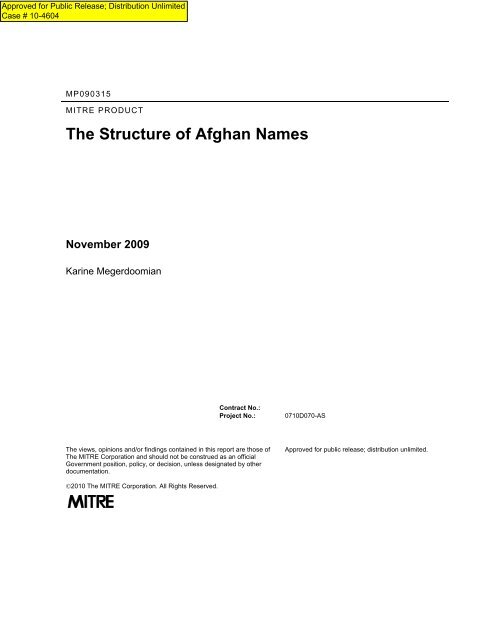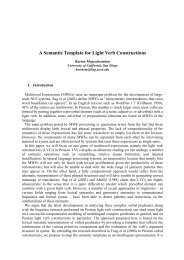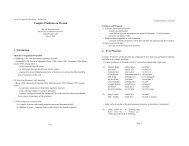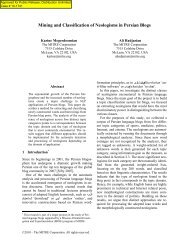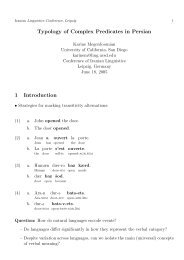The Structure of Afghan Names - Karine Megerdoomian's homepage
The Structure of Afghan Names - Karine Megerdoomian's homepage
The Structure of Afghan Names - Karine Megerdoomian's homepage
You also want an ePaper? Increase the reach of your titles
YUMPU automatically turns print PDFs into web optimized ePapers that Google loves.
MP090315<br />
MITRE PRODUCT<br />
<strong>The</strong> <strong>Structure</strong> <strong>of</strong> <strong>Afghan</strong> <strong>Names</strong><br />
November 2009<br />
<strong>Karine</strong> Megerdoomian<br />
Contract No.:<br />
Project No.:<br />
0710D070-AS<br />
<strong>The</strong> views, opinions and/or findings contained in this report are those <strong>of</strong><br />
<strong>The</strong> MITRE Corporation and should not be construed as an <strong>of</strong>ficial<br />
Government position, policy, or decision, unless designated by other<br />
documentation.<br />
Approved for public release; distribution unlimited.<br />
2010 <strong>The</strong> MITRE Corporation. All Rights Reserved.
Distribution Statement “A": Approved for Public Release 10-4604, Distribution Unlimited<br />
Abstract<br />
This report provides a description <strong>of</strong> the structure <strong>of</strong> <strong>Afghan</strong> names. Person names in<br />
<strong>Afghan</strong>istan <strong>of</strong>ten consist <strong>of</strong> a compound first name. Most people lack a last name and are<br />
generally referred to by their tribal affiliation, place <strong>of</strong> birth, pr<strong>of</strong>ession, or honorific titles.<br />
However, last names are more prevalent in urban and more educated families.<br />
<strong>The</strong> report discusses the various components <strong>of</strong> person names such as titles, honorifics, the<br />
internal structure <strong>of</strong> the name, and various forms <strong>of</strong> address. It also describes some <strong>of</strong> the<br />
issues that arise in the transcription <strong>of</strong> <strong>Afghan</strong> names into English due to a lack <strong>of</strong><br />
standardization and dialectal differences in the pronunciation.<br />
i
Distribution Statement “A": Approved for Public Release 10-4604, Distribution Unlimited<br />
Table <strong>of</strong> Contents<br />
1 Introduction 1<br />
2 <strong>The</strong> Basic <strong>Structure</strong> <strong>of</strong> <strong>Names</strong> 2<br />
2.1 First <strong>Names</strong> 2<br />
2.1.1 <strong>Structure</strong> <strong>of</strong> male names 2<br />
2.1.2 <strong>Structure</strong> <strong>of</strong> female names 3<br />
2.2 Honorifics and Titles 4<br />
2.3 Last <strong>Names</strong> 4<br />
2.4 Name <strong>Structure</strong> 6<br />
3 Issues in Transcription 6<br />
3.1 Segmentation Differences 6<br />
3.2 Dialectal Differences 7<br />
3.3 Issues in Name Transcription 8<br />
4 Forms <strong>of</strong> Address 8<br />
4.1 Patronymic <strong>Names</strong> 8<br />
4.2 Teknonymous <strong>Names</strong> 8<br />
4.3 Kinship <strong>Names</strong> 9<br />
4.4 Nicknames 9<br />
4.5 Titles 10<br />
5 Interpreting <strong>Afghan</strong> <strong>Names</strong> 10<br />
6 References 11<br />
ii
Distribution Statement “A": Approved for Public Release 10-4604, Distribution Unlimited<br />
Table <strong>of</strong> Figures<br />
Figure 1 – National map <strong>of</strong> <strong>Afghan</strong>istan (source: www.afghan-network.net) 1<br />
Figure 2 - Ethnolinguistic groups in <strong>Afghan</strong>istan (source: University <strong>of</strong> Texas, 1997) 5<br />
iii
Distribution Statement “A": Approved for Public Release 10-4604, Distribution Unlimited<br />
List <strong>of</strong> Tables<br />
Table 1 – Dialectal differences in the pronunciation <strong>of</strong> names 7<br />
Table 2 – Kinship terms 9<br />
iv
Distribution Statement “A": Approved for Public Release 10-4604, Distribution Unlimited<br />
1 Introduction<br />
<strong>The</strong> structure <strong>of</strong> person names in <strong>Afghan</strong>istan is very different from those found in a Western<br />
society. This raises certain issues in the transcription <strong>of</strong> <strong>Afghan</strong> names in the United States.<br />
Figure 1 – National map <strong>of</strong> <strong>Afghan</strong>istan (source: www.afghan-network.net)<br />
<strong>Afghan</strong>s traditionally use only a first name and generally lack a last name. People are <strong>of</strong>ten<br />
distinguished by their tribal affiliation, place <strong>of</strong> birth, pr<strong>of</strong>ession or honorific titles. First<br />
names, in particular male names, are <strong>of</strong>ten compound or double names such as Ahmad Navid,<br />
Bashir Bijan, or Ahmad Khan. This is in a way similar to English names such as Mary Ellen<br />
or Billy Bob. <strong>The</strong> first names in <strong>Afghan</strong>istan <strong>of</strong>ten include an Islamic or Arabic component<br />
such as Ahmad, Mohammad, and Ali. Although first names for women may also be <strong>of</strong> Arabic<br />
origin, in general women are given Persian or Pashto names.<br />
Many <strong>Afghan</strong>s that have contact with the Western world adopt a surname. In general, the<br />
educated or prosperous families living in urban areas use last names. In these instances, they<br />
generally select a last name that represents their tribal affiliation as in the case <strong>of</strong> Hamed<br />
Karzai. According to Goering (2002), even if an <strong>Afghan</strong> possesses a last name, the <strong>of</strong>ficial<br />
name generally remains the first name: "An <strong>Afghan</strong> may change his last name at a whim, but<br />
1
Distribution Statement “A": Approved for Public Release 10-4604, Distribution Unlimited<br />
altering the first one requires an application to the government and <strong>of</strong>ficial permission".<br />
(Goering 2002, p.2).<br />
Oftentimes, specific forms <strong>of</strong> address or honorific titles are used in addressing people and<br />
behave as part <strong>of</strong> the proper name. <strong>The</strong>se honorifics generally refer to religious terms (e.g.,<br />
Mullah) or occupation (e.g., Doctor).<br />
In addition, there is no standard orthography in <strong>Afghan</strong>istan and people <strong>of</strong>ten write their<br />
names as they are pronounced in their respective dialects. Hence, the same name may be<br />
pronounced differently based on the geographic region within the country. <strong>The</strong> many ways<br />
available in transcribing a certain sound into English can also add further variance: the<br />
name محمد can be transcribed in many ways including Mohammad, Mohamed, Muhammad,<br />
or Mohamad. <strong>The</strong> lack <strong>of</strong> orthographic standardization, combined with a high level <strong>of</strong><br />
illiteracy, gives rise to many discrepancies in the transcription <strong>of</strong> <strong>Afghan</strong> names into English.<br />
2 <strong>The</strong> Basic <strong>Structure</strong> <strong>of</strong> <strong>Names</strong><br />
2.1 First <strong>Names</strong><br />
2.1.1 <strong>Structure</strong> <strong>of</strong> male names<br />
Male first names generally consist <strong>of</strong> two parts. Oftentimes, at least one <strong>of</strong> the parts includes<br />
a common name that is usually referred to as a "subordinate name", such as Mohammad,<br />
Abdul, Gholam, Ali, Khan, Jan, Shah, Din, and –ullah. Some examples are given below<br />
where the subordinate name has been underlined:<br />
Examples: Mohamad Nabi, Abdul Ghafoor, Jangi Shah, Ali Madad, Ahmad Khan,<br />
Mohammad Nasim, Akhtar Mohammad, Mohammad Sharif, Gholam Sakhi,<br />
Khairullah, Habibullah, Mohammad Zaman, Abdul Qadir, Abdul Waleed,<br />
Ghulam Hazrat<br />
Although the subordinate name is considered as part <strong>of</strong> the full name, the main name or<br />
"proper name" <strong>of</strong> the person is in general the non-subordinate component. Hence, a person<br />
with the name Mohamad Nabi would probably consider his proper name to be Nabi.<br />
Sometimes, both parts <strong>of</strong> the name may be a common name. In these cases, the less frequent<br />
name is generally treated as the proper name <strong>of</strong> the person.<br />
Examples: Abdul Ali, Mohammad Ali, Din Mohammad, Jan Mohamad, Khan<br />
Mohammad, Abdul Mohammad, Ali Mohammad, Ghulam Mohammad<br />
<strong>The</strong>re are also cases where neither component <strong>of</strong> the name is a common name. Again, the<br />
less frequent name is considered to be the "proper name" <strong>of</strong> the person.<br />
Example: Ahmad Zubair (where Zubair is the proper name)<br />
2
Distribution Statement “A": Approved for Public Release 10-4604, Distribution Unlimited<br />
Even though in certain instances the name may include the father's name, this is not<br />
necessarily the case. For instance, the <strong>Afghan</strong> researcher Mohammad Alam gives the<br />
following examples from his own family:<br />
A boy's given name is usually composed <strong>of</strong> two parts or morphemes. <strong>The</strong>se parts may or<br />
may not be part <strong>of</strong> the father's name. For example, my name and my younger brother's<br />
name each shares with our father's name, shown in the following:<br />
My father's name is Sayd Alam.<br />
My name is Mohammad Alam.<br />
My brother's name is Sayd Agha.<br />
My youngest brother's name, however, is Habibullah, which has nothing to do with any<br />
<strong>of</strong> the above names.<br />
[Alam 1975, p. 7]<br />
In rare instances, the male may have a single part name. According to Alam (1975, p. 8), this<br />
is due to the fact that there is no longer a requirement to include an ancestor's name in the<br />
person's name.<br />
Examples: Bashir, Farid, Homayun, Khalil, Raheem, Asad, Dawoud<br />
2.1.2 <strong>Structure</strong> <strong>of</strong> female names<br />
Female names mostly consist <strong>of</strong> a single component.<br />
Examples: Homa, Zeyba, Fereyba, Laila, Nasrin, Nura, Roya, Zaralasht, Marzia,<br />
Meena, Fattema, Shirin, Nazria, Ayesha, Qamar<br />
Female names are sometimes <strong>of</strong> Arabic origin. Oftentimes these are derived from the male<br />
name by adding the /æ/ sound as shown:<br />
Examples: Jamil Jamila, Najib Najiba, Hamid Hamida,<br />
Halim Halima<br />
However, most female names come from Pashto or Persian origin and <strong>of</strong>ten refer to beauty<br />
and nature terms.<br />
Examples: Wazjmakay 'breeze', Nurani 'shiny', Zarghun/Zarghoona 'green',<br />
Torpekay 'brunette', Nasrin 'jonquil', Freshta 'angel', Kawtara 'pigeon',<br />
Spogmay/Spozhmay 'moon'<br />
<strong>The</strong>re are also female names that refer to a legendary personality such as the name <strong>of</strong> the<br />
<strong>Afghan</strong> politician Malalai Joya, which refers to Malalai – the <strong>Afghan</strong> heroine that played an<br />
important role in the battle <strong>of</strong> Maiwand against the British in 1880.<br />
In rare instance, female names may consist <strong>of</strong> two parts.<br />
Examples: Khan Begom, Begom Jan, Gol Khanom<br />
3
Distribution Statement “A": Approved for Public Release 10-4604, Distribution Unlimited<br />
2.2 Honorifics and Titles<br />
In <strong>Afghan</strong> Persian or Dari, honorifics are <strong>of</strong>ten used by both women and men as part <strong>of</strong> the<br />
name as shown in the examples below. Khan can only be used with men's names while Jan<br />
can appear with both female and male names.<br />
Examples:<br />
Male names. Sharif Khan, Latif Khan, Khalil Khan, Gul Khan, Khalil Jan,<br />
Gholam Jan<br />
Female names. Sharifa Jan, Latifa Jan, Homa Jan<br />
Honorific names can be inherited from the tribe and then be added to the two-part name.<br />
Other honorifics signify a religious position (e.g., Mullah Mohamed Omar also known as<br />
Mullah Omar), military rank (e.g., Jangran Shamshir Khan), or nobility or government rank<br />
(e.g., Sardar Mohamad Dawoud Khan). Some common honorifics are listed below:<br />
<br />
Religious: Agha, Hazrat, Khoja/Khwajah, Mir, Saybzada, Sheykh, Hajji, Akhwand,<br />
Mullah, Alim/Olim, Hafiz, Maulvi/Malawai/Mulawai, Mudari<br />
Military: Ghazi, Amir, Komandon, Dagerwal, Jenral, Jagran<br />
Nobility/Chief: Malik, Padishah/Padshah, Ustaz/Ustad, Safi, Sardar<br />
In addition, the inherited honorific may be used in conjunction with sayb 'sir'.<br />
Examples: Mir-sayb, Hazrat-sayb, Khoja-sayb, Sardar-sayb<br />
Recently, some new titles have been developed that are closer to the Western-style titles<br />
such as the Pashto terms Shaghelay 'Mr.', Mermon 'Mrs.', Peghal 'Miss', as well as<br />
occupation-related titles such as Doctor or Engineer.<br />
2.3 Last <strong>Names</strong><br />
Most <strong>Afghan</strong>s do not have a last name but may choose one if they are in contact with<br />
other cultures. In general, families living in urban areas, middle class families, and those<br />
with higher education tend to have last names. In any case, the last name is selected by<br />
the individual and can represent a father's name, a tribal affiliation, or an adjective<br />
describing the person. This may result in people within the same family having different<br />
last names, as in the case <strong>of</strong> Dr. Abdul Zahir (a former <strong>Afghan</strong> parliament head) and Dr.<br />
Abdul Kayeum (a former second deputy prime minister), who were actually brothers.<br />
Goering (2002) provides the example <strong>of</strong> Ghulam Farouq:<br />
Farouq's father, for instance, is Ghulam Sakhi and by rights his son should be Ghulam<br />
Farouq Sakhi. But Farouq's older brother decided to take for himself the last name<br />
Samim, which means "very friendly" or "well-decided." When the brother died in a plane<br />
crash, Farouq assumed the name in his brother's honor.<br />
4
Distribution Statement “A": Approved for Public Release 10-4604, Distribution Unlimited<br />
[…] To complicate matters, nearly all <strong>Afghan</strong>s, while they may not have a last name, do<br />
have a tribal name, which they add at the end when they feel like it. Technically, Farouq<br />
is Ghulam Farouq Samim Omarkhil, though he <strong>of</strong>ten drops the Pashtun suffix.<br />
[Goering 2002, p. 2]<br />
Figure 2 - Ethnolinguistic groups in <strong>Afghan</strong>istan (source: University <strong>of</strong> Texas, 1997)<br />
Last names <strong>of</strong>ten refer to the name <strong>of</strong> the tribe that the person belongs to or is affiliated<br />
with. <strong>The</strong> following are the common forms <strong>of</strong>ten encountered:<br />
End in –ai or –i, usually added to the place or area <strong>of</strong> origin<br />
Examples: Karzai (from Karz in Kandahar), Sipai, Marghai, Panipai, Durani,<br />
Kohistani, Sanjari, Rahimi, Sabari, Khajuri, Hussaini (generally <strong>of</strong> Hazar<br />
origin), Turtughi (<strong>of</strong> Uzbek origin)<br />
End in –zai, which represents the inflected form <strong>of</strong> zoy 'son'<br />
Examples: Ghilzai, Yousafzai, Mamadzai/Muhammadzai, Qalzai, Isupzai, Popalzai,<br />
Noorzai, Sinzai, Usmanzai<br />
5
Distribution Statement “A": Approved for Public Release 10-4604, Distribution Unlimited<br />
End in –khel/khil, meaning 'branch'<br />
Examples: Suleiman Khel, Jalal Khel, Kabul Khel, Umarkhil<br />
Contains –gul<br />
Examples: Gulmamad, Gulbodeen, Gulzar, Gulbaz<br />
Other tribal names<br />
Examples: Kizilbash, Hotaki, Turan, Marwat, Mohmand, Burhan<br />
Women tend to adopt the last names <strong>of</strong> the husbands or <strong>of</strong> the fathers.<br />
Note that the basic honorifics generally cannot be dropped and are treated as an integral<br />
part <strong>of</strong> the name. <strong>The</strong>se honorifics are underlined in the following examples:<br />
Examples: Khan Mohammad, Jan Mohamad, Sayd Alam<br />
2.4 Name <strong>Structure</strong><br />
As already discussed, <strong>Afghan</strong> names include a "proper name", which refers to the main<br />
name one would call someone by, and a "subordinate name".<br />
(1) (SubordinateName) + ProperName = FirstName<br />
ProperName + (SubordinateName) = FirstName<br />
In cases where the person has only one subordinate name, the proper name is considered<br />
to be the main first name. In the case <strong>of</strong> Ahmad Shah, for instance, Ahmad would be<br />
considered the main first name.<br />
If there are two subordinate names, then the less frequent name is treated as the main<br />
first name. For example, both parts <strong>of</strong> the name Gholam Mohammad are common or<br />
subordinate names; in this case the less frequent name, namely Gholam, would be used<br />
as the main first name.<br />
3 Issues in Transcription<br />
3.1 Segmentation Differences<br />
<strong>The</strong> fact that most <strong>Afghan</strong> names do not contain a last name results in various segmentations<br />
<strong>of</strong> the names.<br />
In general, the second component <strong>of</strong> male names (e.g., Gul, Khan, Hassan, Gholam,<br />
Mohammad) is <strong>of</strong>ten treated as a last name when transcribed into English. A person with the<br />
name Jan Mohammad would therefore be treated as having the first name Jan and the last<br />
name Mohammad. And Abdul Haq, the Pashtun leader who was executed by the Taliban in<br />
October 2001, was quoted in the Western press as Haq or Mr. Haq. Similarly, the honorifics<br />
Khan and Jan (mentioned in Section 2.2) are <strong>of</strong>ten used as a last name in the West. Hence, a<br />
6
ښپ<br />
Distribution Statement “A": Approved for Public Release 10-4604, Distribution Unlimited<br />
person named Gul Khan may be treated as having the first name Gul and the last name Khan<br />
in the United States.<br />
If the person's name contains only a single component as in Abdulshukr or Habibullah, he<br />
may be asked to come up with a last name. This has been the case <strong>of</strong> several <strong>Afghan</strong>s who<br />
have chosen the name <strong>of</strong> their father as their last names (e.g., Habibullah Abdulghaffar) or<br />
have selected the geographic location (e.g. village) <strong>of</strong> an ancestor as the last name (e.g.,<br />
Mohamad Zaman Naderi).<br />
In some cases, <strong>Afghan</strong>s whose second name is considered to be the proper name choose to<br />
keep the proper name as their main first name in other cultures and to abbreviate the first<br />
component. For example, Ahmad Zubair Kuhestani may decide to go by his proper name<br />
Zubair and transcribe his full name as A. Zubair Kuhestani in English.<br />
3.2 Dialectal Differences<br />
<strong>The</strong>re exist two main dialects <strong>of</strong> Pashto:<br />
<strong>The</strong> Western dialect spoken in Kandahar, Helmand, Farah, among other locations<br />
<strong>The</strong> Eastern dialect spoken mainly in Jalalabad, Nangarhar, Paktia, Khost, and the<br />
North-West Frontier Province (NWFP) <strong>of</strong> Pakistan<br />
Western Dialect Eastern Dialect Meaning<br />
Shayesteh Khayesteh beautiful<br />
Breshna Brekhna lightning<br />
Spozhmey Spogmey moon<br />
Wazhma Wagma breeze<br />
Shkulai Khekulai beautiful<br />
Shaperai Khaperai fairy<br />
Khwazha Khwaga sweet<br />
Table 1 – Dialectal differences in the pronunciation <strong>of</strong> names<br />
<strong>The</strong>se two dialects have distinct pronunciations, even <strong>of</strong> the same words. For instance, the<br />
speakers <strong>of</strong> the Western dialect pronounce the name <strong>of</strong> the language as Pashto while the<br />
speakers <strong>of</strong> the Eastern dialect would pronounce it as Pukhto. This is due to the fact that the<br />
written letter ښ (used in writing the word Pashto ) is pronounced as a 'sh' in the Western<br />
dialect and as a 'kh' in the Eastern dialect. Similarly, the written letter ږ is pronounced as a<br />
'zh' in the Western dialect and as a 'g'' in the Eastern. <strong>The</strong>se distinct pronunciations give rise<br />
to different transcriptions <strong>of</strong> names. Some examples are given in Table 1.<br />
تو<br />
7
Distribution Statement “A": Approved for Public Release 10-4604, Distribution Unlimited<br />
A similar variance may occur with honorifics. For instance, the different pronunciations <strong>of</strong><br />
the letter و in the dialects provides the alternate spellings <strong>of</strong> آخوند as<br />
خوجه or خواجه Akhund/Akhoond and Akhwand (a Muslim cleric), and the honorific<br />
may be transcribed as either Khoja or Khwajah.<br />
3.3 Issues in Name Transcription<br />
<strong>The</strong>re are no existing standards in Pashto orthography. Dari speakers generally follow the<br />
standards developed for Iranian Persian, although some minor differences may exist. In<br />
addition, the transcription <strong>of</strong> <strong>Afghan</strong> names into English has not really been standardized.<br />
Dialectal differences may also cause different pronunciations for the same name. <strong>The</strong>se<br />
elements, in addition to the segmentation issues discussed in Section 3.1, give rise to a high<br />
level <strong>of</strong> variance in transcribing <strong>Afghan</strong> names.<br />
<strong>The</strong>re are also variants in the English rendering, not unlike the issues encountered in<br />
transcribing Arabic names. For instance, the name مسعود can be transcribed as Massoud,<br />
Masoud, Ma'sud, or Massood; and فاروق may be represented as Farouq, Farough, Farooq, or<br />
Farook. Spacing between two parts <strong>of</strong> a name may not always be present. Hence, both forms<br />
Miakhel or Mia Khel may be common and the name Shah Mahmood may also be transcribed<br />
as Shahmahmood.<br />
An additional issue arises from the fact that some people in <strong>Afghan</strong>istan go by different<br />
names based on the situation or context. For instance, they may be referred to by their<br />
honorific name in certain situations and with their first name at other times.<br />
4 Forms <strong>of</strong> Address<br />
In <strong>Afghan</strong>istan, as in many Middle Eastern countries, the first name is <strong>of</strong>ten not used to refer<br />
to a person. This indicates politeness and respect. <strong>The</strong>re are several forms <strong>of</strong> address that can<br />
be used instead to address someone, as described in this section.<br />
4.1 Patronymic <strong>Names</strong><br />
Children may be addressed by their father's name instead <strong>of</strong> using their first name.<br />
Examples: Bache Sharif 'son <strong>of</strong> Sharif', doxtare Karim 'daughter <strong>of</strong> Karim', doxtare<br />
Golbibi 'Golbibi's daughter'<br />
It is also possible to use the father's title or position in referring to the child:<br />
Examples: Bache rayis 'son <strong>of</strong> the President, doxtare wazir 'daughter <strong>of</strong> the Minister'<br />
4.2 Teknonymous <strong>Names</strong><br />
When addressing an older person, one may use the combination <strong>of</strong> a kinship name and a<br />
relative's first name.<br />
8
Distribution Statement “A": Approved for Public Release 10-4604, Distribution Unlimited<br />
Examples: Pedare Layla 'Layla's father'<br />
Married couples generally refer to each other by the name <strong>of</strong> the eldest child (boy or girl) or<br />
in some occasions by the name <strong>of</strong> the second eldest, rather than addressing each other with<br />
the first name.<br />
Examples: Madare/Boboye Gholam 'mother <strong>of</strong> Gholam', Aghaye/Babe Gholam<br />
'father <strong>of</strong> Gholam'<br />
4.3 Kinship <strong>Names</strong><br />
Young people address the older person in the family with a kinship name. <strong>The</strong> first name <strong>of</strong><br />
the older person is almost never used in the family. Some kinship names are provided in<br />
Table 2.<br />
Kinship term<br />
madar, bobo, nana<br />
baba, agha<br />
beradar<br />
amshira, xwar<br />
zan, xanom<br />
shawar, shuy<br />
lala, kaka<br />
apa, xowar, amshira<br />
mama, xalu<br />
kaka, amu<br />
xala<br />
ama<br />
Translation<br />
mother<br />
father<br />
brother<br />
sister<br />
wife<br />
husband<br />
elder brother<br />
elder sister<br />
uncle (maternal)<br />
uncle (paternal)<br />
aunt (maternal)<br />
aunt (paternal)<br />
4.4 Nicknames<br />
Table 2 – Kinship terms<br />
In some instances, people may be given a nickname used to refer to them. In these cases,<br />
people may simply be addressed by their nickname and the first name is not used.<br />
Ox-Name. One <strong>of</strong> the common nickname categories, the "ox-name", is a nickname that<br />
refers to a brave animal or to beauty and nature.<br />
9
Distribution Statement “A": Approved for Public Release 10-4604, Distribution Unlimited<br />
Examples: Ezmaray 'lion', Toryalay 'brave', Gorg 'wolf', Sheragha 'master <strong>of</strong> the<br />
lion', Golagha 'master <strong>of</strong> the flower', Gol 'flower', Ghotay 'plant', espozhmay<br />
'moon', Qamar 'moon', Setara 'star', Storay 'star'<br />
Abbreviations. <strong>Names</strong> can be abbreviated by dropping the subordinate name, or by<br />
eliminating syllables to create a new form as in the second set <strong>of</strong> examples below:<br />
Examples: Najibullah Najib, Qodratullah Qodrat, Mohammad Zaher <br />
Zaher<br />
Examples: Mohammad Ullah Madulah, Khan Mohammad Khanmad,<br />
Jan Mohamad Janmad<br />
Diminutives. "Diminutives" are <strong>of</strong>ten used for children and close friends. <strong>The</strong>y can be the<br />
shortened form <strong>of</strong> the name combined with the –o suffix.<br />
Examples: Najmudin Najo, Qodbedin Qodo, Khalil Khalo<br />
<strong>The</strong>y may also be formed by adding the diminutive suffix –ak or –gak. However, in these<br />
cases, the newly formed word will be used as a form <strong>of</strong> address but not as the proper name <strong>of</strong><br />
the person.<br />
Examples: Bachagak 'little boy', Dokhtarak 'little girl'<br />
4.5 Titles<br />
Titles such as 'Mrs' or 'Mr' may be used in addressing people. However, even if a person<br />
possesses a last name, the latter is not generally used to refer to him or her as one might do in<br />
the West. Hence, one may refer to the woman named Shafiqa Zeyaiy as Mermon Shafiqa<br />
'Mrs. Shafiqa', Mermon Shafiqa Zeyaiy 'Mrs. Shafiqa Zeyaiy', but not with only a title and a<br />
last name as in Mermon Zeyaiy 'Mrs. Zeyaiy'.<br />
In addition, the occupation or position <strong>of</strong> a person is <strong>of</strong>ten used in addressing them. It should<br />
be noted that these should not necessarily be transcribed as the name <strong>of</strong> the person as they<br />
are forms <strong>of</strong> address referring to the occupation as in the case <strong>of</strong> Rayisayb 'Mr. President'.<br />
Examples: Engineer Gholam, Dr. Gholam Nabi Jawad, Rayisayb 'Mr. President',<br />
Merzasayb 'Mr. Clerk', Modirsayb 'Mr. Principal', Khalifasayb 'Mr. Serviceman'<br />
5 Interpreting <strong>Afghan</strong> <strong>Names</strong><br />
<strong>The</strong>re exist differences between ethnic groups in naming and one might be able to infer the<br />
tribal affiliation or ethnic origin <strong>of</strong> a person based on the name alone. For instance, Pashtuns<br />
will have more Pashto names (e.g., Turyalai Muhammadzai for a male, Shaperai Isupzai for<br />
a female), while Dari speakers will have more Persian first or last names (e.g., Bashir Bijan<br />
for a male, Shirin Kuhestani for a female). Hazara names may contain more Shiite-related<br />
names, such as Ali or Hossain (e.g., Sadiq Ali, Hassan Ghulam, Ghulam Hussain).<br />
10
Distribution Statement “A": Approved for Public Release 10-4604, Distribution Unlimited<br />
In addition, nicknames and honorifics can provide information with respect to the person.<br />
For example, the name Yusufzai sayb indicates that the person is a male, worthy <strong>of</strong> respect<br />
(sayb means 'sir'), and from the Yusufzai tribe.<br />
6 References<br />
Glatzer, Bernt (2002). <strong>The</strong> Pashtun Tribal System. In G. Pfeffer & D. K. Behera (eds.):<br />
Concept <strong>of</strong> Tribal Society (Contemporary Society: Tribal Studies, Vol 5). New Delhi:<br />
Concept Publishers, pp 265-282.<br />
Goering, Laurie (2002). What's your name? can be tricky query. Chicago Tribune, June 19,<br />
2002.<br />
Miakhel, Shahmahmood (2008). <strong>The</strong> Importance <strong>of</strong> Tribal <strong>Structure</strong>s and Pakhtunwali in<br />
<strong>Afghan</strong>istan: <strong>The</strong>ir Role in Security and Governance. In Shipra Arpita Basu Roy (ed.):<br />
Challenges and Dilemmas <strong>of</strong> State-Building in <strong>Afghan</strong>istan: Report <strong>of</strong> a Study Trip to<br />
Kabul. Vedams Books.<br />
Miran, M. Alam (1975). Naming and Address in <strong>Afghan</strong> Society. ERIC digest ED 109 915.<br />
Robson, Barbara and Juliene Lipson (2002), with Farid Younos and Mariam Mehdi. <strong>The</strong><br />
<strong>Afghan</strong>s: <strong>The</strong>ir History and Culture. Washington, DC: Center for Applied Linguistics.<br />
http://www.cal.org/CO/afghan/index.html<br />
Samuel, Ken (2009). Dari and Pashto: Overview <strong>of</strong> Dari and Pashto for Name Matching.<br />
Unpublished manuscript, MITRE Corporation.<br />
Tegey, Habibullah and Barbara Robson (1993). Beginning Pashto: Workbook, Washington,<br />
DC: Center for Applied Linguistics.<br />
Tidwell, Chay (2009). Guide for <strong>Afghan</strong> <strong>Names</strong> in Pashto and Dari. HTT AF-4; February<br />
2009.<br />
Zawaydeh, Bushra (2009). <strong>The</strong> <strong>Names</strong> <strong>of</strong> <strong>Afghan</strong>istan: Understanding Pushto and Dari<br />
<strong>Names</strong>. Presentation, Basis Technology Government Users Conference.<br />
Name List References<br />
<strong>The</strong> following sources were used in compiling and studying the structure <strong>of</strong> <strong>Afghan</strong> names:<br />
<br />
<br />
<br />
<br />
<br />
<strong>Afghan</strong>istan Tribal Hierarchy, compiled by the Courage Corporation<br />
<strong>Afghan</strong> first names for males and females<br />
http://www.khyber.org/culture/names/names.shtml<br />
<strong>Afghan</strong> first names with ethnic origin<br />
http://www.afghanfun.com/names/pesar/alef/<br />
<strong>Afghan</strong> Forum: "what are common <strong>Afghan</strong> surnames?"<br />
http://www.afghanforums.com/archive/index.php/t-7948.html<br />
Historical <strong>Afghan</strong> names<br />
http://www.khyber.org/charts/afghanchronology.shtml<br />
11
Distribution Statement “A": Approved for Public Release 10-4604, Distribution Unlimited<br />
<br />
<br />
<br />
<br />
<br />
List <strong>of</strong> Hazara delegates to the Loya Jirga<br />
www.hazara.net/jirga/HazaraDelegates.pdf<br />
List <strong>of</strong> the civilian deaths in <strong>Afghan</strong>istan<br />
http://www.afghanvoice.com/forum/viewtopic.php?f=2&t=279<br />
<strong>Afghan</strong> names<br />
http://www.afghanonline.com/afghannames/<br />
List <strong>of</strong> presidential candidates in <strong>Afghan</strong>istan<br />
http://afghannevesht.blogspot.com/2009/05/blog-post_23.html<br />
Voice <strong>of</strong> America name pronunciation guide<br />
http://names.voa.gov/index.cfm<br />
12


